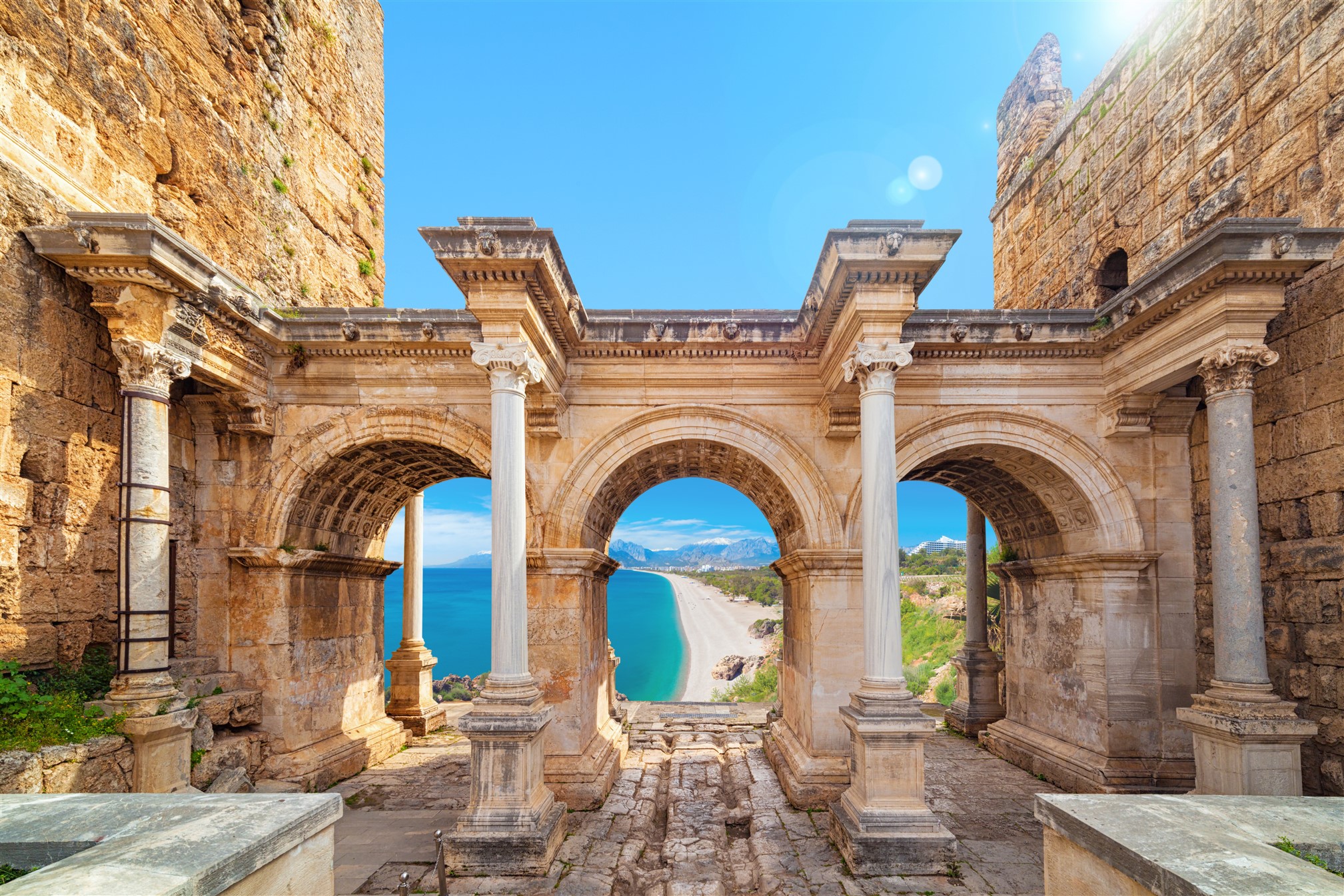Aesthetic Travel Antalya
Calculate Your Cost / Price
-
Aesthetic Travel Antalya
-
Gastric Balloon in Antalya
-
What is a Gastric Balloon?
-
How is Gastric Balloon Placement Procedure Done?
-
Who Can Undergo Gastric Balloon Treatment in Turkey?
-
Gastric Balloon Prices in Turkey
-
Non-Surgical Gastric Reduction in Turkey
-
Gastric Balloon in Turkey
Why antalya for Bariatric Surgery & Aesthetic Travel ?

Antalya, a popular tourist destination in Turkey, has become increasingly known for medical tourism, including aesthetic and obesity-related procedures. Several factors contribute to Antalya's popularity for obesity aesthetic travel Antalya:
- Quality Medical Facilities: Antalya boasts modern and well-equipped medical facilities that adhere to international standards. Many hospitals and clinics in the region have experienced medical professionals and advanced technology for obesity-related surgeries and aesthetic procedures.
- Experienced Healthcare Professionals: Antalya attracts skilled and experienced surgeons and medical professionals who specialize in obesity-related surgeries and aesthetic treatments. These professionals often have international training and certifications, providing a level of expertise that is crucial for medical tourism.
- Cost-Effective Procedures: Medical procedures in Antalya are often more affordable compared to many Western countries. The lower cost of living in Turkey contributes to competitive pricing for obesity and aesthetic treatments, making it an attractive option for those seeking cost-effective solutions.
- Tourist-Friendly Environment: Antalya is a popular tourist destination known for its beautiful landscapes, historical sites, and vibrant culture. The city's welcoming atmosphere and diverse attractions make it an appealing destination for individuals looking to combine medical treatments with a vacation experience.
- High-Quality Accommodations: Antalya offers a range of accommodation options, from luxury hotels to budget-friendly alternatives. Patients traveling for medical purposes can find comfortable and convenient places to stay during their recovery.
- Warm Climate and Scenic Environment: The Mediterranean climate in Antalya, characterized by mild winters and hot summers, can be beneficial for patients during their recovery. The scenic beauty of the region provides a peaceful and relaxing environment for individuals undergoing aesthetic or obesity-related treatments.
- Streamlined Medical Tourism Services: Antalya has developed a robust infrastructure to support medical tourism, with agencies and services that cater specifically to international patients. These services often assist with travel arrangements, accommodation, language translation, and other logistical aspects of medical travel.
- It's important to note that individuals considering obesity-related surgeries or aesthetic procedures in Antalya should thoroughly research and choose reputable healthcare providers. Additionally, consulting with a healthcare professional before making any decisions is crucial to ensure that the chosen procedures are medically suitable for the individual's specific needs and health conditions.
ENDOSCOPIC GASTRIC BALLOON in Antalya / Turkey
During the endoscopic gastric balloon procedure, sedation is administered to make the patient more comfortable. Since the procedure is performed using an endoscopic technique, the patient is advised not to eat or drink anything for a certain period of time before the procedure. The necessary preparations before the procedure are explained to the patient. During the balloon placement stage, an endoscope, which is a thin and flexible tube with a camera at the tip, is inserted into the stomach, and the balloon is placed in the stomach. Then, the balloon is inflated with saline or a completely compatible and health authority-approved blue dye. The inflated balloon occupies approximately more than half of the stomach. Since everyone's stomach structure and anatomy are not the same, the decision on how much to inflate the balloon is made during the procedure. The endoscopic gastric balloon procedure is completed within approximately 30 minutes to 1 hour.
SWALLOWABLE GASTRIC BALLOON in Antalya / Turkey
While endoscopic gastric balloon treatment has been successfully applied for many years, swallowable gastric balloon or elipse gastric balloon procedures have gained prominence as alternative methods due to the lack of sedation during the procedure and the absence of endoscopic assistance. In the swallowable gastric balloon procedure, the patient swallows a capsule-shaped balloon attached to a thin wire in an uninflated state with plenty of water. For patients who have difficulty swallowing the balloon, the doctor can assist the patient in swallowing the balloon using a thin guide wire. Once the balloon reaches the stomach, the doctor verifies its correct placement through imaging methods such as X-rays. An apparatus resembling a thin wire at the end of the balloon allows for inflation of the balloon. The doctor ensures that the balloon is correctly positioned and proceeds to inflate the balloon using approximately 500 mL of water containing potassium sorbate. After inflating the balloon to the desired extent, the final position is rechecked. Following thorough checks, the apparatus at the end of the balloon is carefully removed by the expert doctor. The swallowable gastric balloon procedure takes approximately 20 minutes. Since no anesthesia is administered during the procedure, the patient can return to their daily life shortly afterward. The swallowable gastric balloon has a leak-proof and soluble valve. Approximately 4 months later, the valve dissolves, the fluid inside the balloon is emptied, and the deflated balloon passes through the intestines and is excreted from the body. Due to the absence of anesthesia and endoscopy during placement and removal, the swallowable gastric balloon is one of the preferred methods for patients who have been unsuccessful in losing weight through diet and exercise.
Who Can Undergo Gastric Balloon Treatment in Antalya / Turkey?
Not every overweight or obese patient is suitable for a gastric balloon. So, who can undergo gastric balloon treatment? The body mass index of the patient is crucial for gastric balloon treatment. For individuals with a body mass index below 30 or above 40, alternative treatment options may need to be considered. Additionally, individuals who do not meet these criteria but need to lose weight quickly due to health issues such as diabetes or cardiovascular diseases may be eligible for gastric balloon treatment based on the doctor's discretion.
Gastric Balloon Prices in Antalya / Turkey
Gastric balloons are made of materials that can remain in the body for 6 to 12 months. Gastric balloon prices vary depending on factors such as the type of balloon used in the procedure and the duration it remains in the body.
Non-Surgical Gastric Reduction in Turkey
Non-surgical gastric reduction methods aim to reduce the volume of the stomach without any incisions or stitches, assisting patients in rapid weight loss. Methods such as swallowable gastric balloon are among the non-surgical gastric reduction methods preferred for the treatment of obesity. Non-surgical gastric reduction methods, including gastric balloon, are successfully performed by experienced and specialized physicians in our hospitals. If you want to lose weight, you can visit our obesity clinics to undergo a thorough examination to determine your suitability for the procedure and to receive information and make an appointment.

12 effective methods to lose weight while sleeping
Aesthetic Travel Antalya, Aesthetic Travel Turkey, Lose weight while sleeping
Losing weight and staying at the ideal weight is the first step to a healthy life. Maintaining an ideal weight as well as an active life prevents the occurrence of many serious diseases. Very simple and effective methods applied in daily life can provide successful results in weight loss. A few important tips supported by effective methods can open the doors to a healthy life.
Fat burning is possible while sleeping. In order to understand whether fat burning has occurred or not, it is possible to evaluate and understand the situation by weighing yourself before and after sleeping. Using a more sensitive scale in this weighing method will make the job easier for individuals with low weight. Although there are 4 different stages of sleep, the phase in which fat burning occurs the most is the delta wave. The intense release of growth hormone that occurs in the delta phase is a great supporter of fat burning during sleep. In order for the body to burn fat, it must remain hungry for 12 hours. Another explanation is that it seems ideal to start with the 16-8 nutrition method, both in diet psychology and by integrating it with intermittent fasting, and that it is necessary to create a feeling of fullness while dieting with this nutrition method.
HOW TO BURN FAT WHILE SLEEPING?
Care should be taken to increase sleep duration and quality. It is very important to sleep in a dark environment. Sleeping in a dark area will increase the release of melatonin hormone and also support growth hormone. Avoid sleeping in front of a mobile phone or computer, that is, exposed to blue light. Instead, it may be preferred to fall asleep by reading a book. Care should be taken to sleep before 23:00. How the biological clock works; If the first wave of 90 minutes is missed, the next wave will have to be waited. So you may have to wait until after midnight. If there is a sleep problem, B1 group vitamin supplements can be used. It is especially appropriate for people suffering from waist and back pain to take D3 support. Constant awakenings indicate high cortisol levels. Zinc supplements can be taken to provide a solution to such situations of constant waking up.
12 effective methods to lose weight while sleeping
- Focus on your breathing, a good breath means a deep sleep.
- One of the biggest enemies of sleep is stress. Go out, stay in touch with nature, do physical work and do activities that will cause body fatigue.
- If you experience frequent urination, you can use special nutrition methods such as ketogenic or intermittent fasting during your sleep. Immediately stop late-night feedings and snacks.
- Get into the habit of not eating after 19:00.
- Exercise. Use intense, short-term, not excessive exercises with plenty of rest.
- Do not consume protein, carbohydrates or sugary foods at night.
- Unless you have a chronic disease, be careful not to overeat before and after your workouts. Stop feeding 3 hours before and after.
- Take care to eat organic and clean.
- If you are taking a vitamin supplement and exercising during the day, take it 4 hours before sleep.
- Niacin and arginine can affect growth hormone better and help lose more weight.
- Combining intermittent fasting with sleep thoroughly supports fat burning during sleep.
- If you consume alcohol, stop. Drinking alcohol prevents the body from switching to REM frequency.
FQ About Gastric Balloon Clinic in Antalya / Turkey
Gastro consultants are specialists in diagnosing and treating conditions related to the digestive system, including the stomach, intestines, liver, and pancreas. They help manage conditions like irritable bowel syndrome (IBS), inflammatory bowel disease (IBD), acid reflux, ulcers, and gastrointestinal cancers. Regular consultations are key for patients with chronic digestive issues or those undergoing treatments like bariatric surgery.
Always consume lean protein first, non-starchy vegetables second, and high-fiber carbs or a healthy fat source last. Try to consume at least 64 ounces of hydrating fluids. Avoid added-sugar drinks, carbonation, and excessive caffeine. Consume alcohol in moderation. Bread, Rice, and Pasta - Because of the starchy nature of bread, rice, and pasta, after your surgery, they can form a paste in your throat that is hard to swallow without liquid. In some cases, they can block the stoma, the hole to the pouch that is... +More
Foods to Avoid After Bariatric Surgery TurkeyRed meat that's tough or dry.Greasy, high fat foods.Heavily seasoned or spicy foods.Sugar alcohols, such as erythritol, glycerol, mannitol, sorbitol and xylitol.Foods reheated in the microwave. In addition, avoid the ancillary foods that can be even worse than the fast-food entrée itself. Sodas, french fries, other fried sides and even salad dressings can all contain tons of fat, sugar and ultimately calories Since salads are typically made of raw fruits and... +More
Many studies found that Gastric Bypass surgery boasted the greatest weight loss short and long term and for years it has been known as the Gold Standard for weight loss. Bariatric Surgery Turkey Price For more details in our article, Which bariatric surgery loses the most weight in Istanbul where you will find all the information about Which bariatric surgery loses the most weight in Istanbul please contact us. Which bariatric surgery loses the most weight in Istanbul Many studies found that Gastric Bypass... +More
Sleeve banding combines two bariatric procedures: the gastric sleeve and an adjustable gastric band. It is a less common technique used to enhance the weight-loss results of the sleeve by adding additional restriction through the band. However, complications from the band have made it less favorable in recent years.
The gastric sleeve procedure in Antalya is generally safe, with complication rates similar to global standards. The death rate for gastric sleeve surgery is extremely low, typically less than 1%. Most hospitals in Antalya follow international safety standards and use modern techniques to reduce the risk of complications. However, like any surgery, it does carry risks such as infection, bleeding, or complications from anesthesia. Patients are encouraged to research the qualifications of the surgeon and the clinic... +More
The Vertical Sleeve Gastrectomy is the most widely used, and safest, in the bariatric world. As with any major surgery, gastric bypass and other weight-loss surgeries pose potential health risks, both in the short term and long term. Bariatric Surgery Turkey Price For more details in our article, What is the safest bariatric surgery for weight loss in Turkey where you will find all the information about What is the safest bariatric surgery for weight loss in Turkey please contact us. What is the safest bariatric... +More
A Gastrointestinal (GI) doctor, also known as a gastroenterologist, specializes in diagnosing and treating conditions affecting the digestive system. This includes the esophagus, stomach, intestines, liver, pancreas, and gallbladder. Common reasons to see a GI doctor include chronic heartburn, abdominal pain, irritable bowel syndrome (IBS), Crohns disease, and more. GI doctors play a critical role in managing post-operative care for patients who have undergone bariatric surgery to ensure proper digestion and... +More
Obesity surgery encompasses various procedures designed to help patients lose weight and manage obesity-related health conditions. These include gastric sleeve, bypass, and non-surgical options like the intragastric balloon. Turkey is one of the most popular destinations for these surgeries, attracting patients from all over the world.
The gastric balloon procedure, while less invasive than the gastric sleeve, is not without its risks. Some patients report severe complications, such as persistent vomiting, intense discomfort, or early deflation of the balloon. Horror stories involving gastric balloon procedures highlight the importance of post-operative care and choosing an experienced surgeon.
A bowel specialist, or gastroenterologist, diagnoses and treats diseases of the digestive tract, including the stomach, intestines, and colon. Common conditions treated include IBS, Crohns disease, ulcerative colitis, and colon cancer.
Pages
-
£ 1580£ 1450GASTRIC BALLOON PROCEDURE PACKAGE
Give a call to learn more about what’s included and to come up with a tailored plan if you need unique accommodations that are not listed below.
- Airport
- Hotel
- Hospital transfer
- The balloon is placed via endoscopy, the procedure takes 15-20 minutes and you are discharged after 2-3 hours. It is enough to stay here for 1 night.
- Blood samples & x-rays
- 5 year follow up
-
£ 2750£ 2550GASTRIC SLEEVE PACKAGE
GASTRIC SLEEVE PACKAGE COST TURKEY / ANTALYA
Give a call to learn more about what’s included and to come up with a tailored plan if you need unique accommodations that are not listed below.- Airport
- Hotel
- Hospital transfer
- 4 day stay at hospital
- Blood samples & x-rays
- 5 year follow up
-
£ 3100£ 2900MINI GASTRIC BYPASS PACKAGE
MINI GASTRIC BYPASS PACKAGE TURKEY
Give a call to learn more about what’s included and to come up with a tailored plan if you need unique accommodations that are not listed below.- Airport
- Hotel
- Hospital transfer
- 4 day stay at hospital
- Blood samples & x-rays
- 5 year follow up












